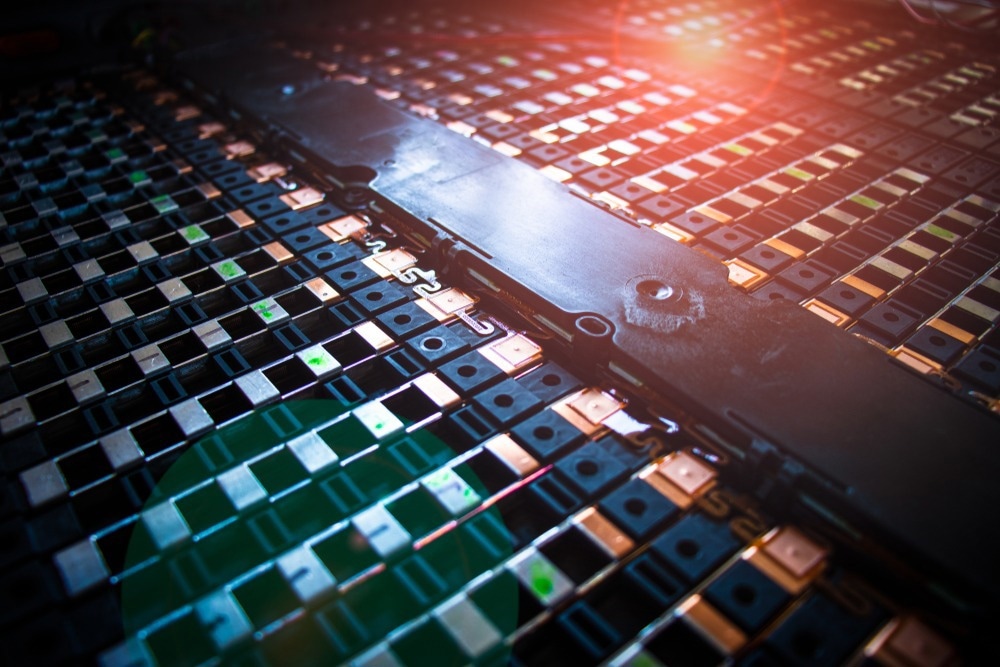Electric vehicles (EVs) have become more popular over the past several years due to many environmental benefits, including zero-carbon tailpipe emissions, higher powertrain efficiency, and less urban air pollution. However, the problems posed by the manufacture and end-of-life processes of electric vehicles affect the industry’s advancement. This article will look at second-life batteries as a possible solution to these EV issues.

Image Credit: P5h/Shutterstock.com
The Reuse and Recycling of Li-ion Batteries
Reusing and recycling lithium-ion batteries has challenged the automotive industry in recent years. The footprint of EV manufacturers is affected heavily by the extraction of the materials necessary for producing Li-ion batteries. The waste produced places various demands on the recycling and end-of-life dismantling systems within the industry.
The metals used in these batteries are very difficult to extract, so the reuse of lithium-ion batteries or recycling of their internal components would significantly reduce their cost, making EVs even more accessible. However, this does not account for the lifespans of the batteries, which most car manufacturers, such as Nissan and Tesla, quote to be eight years or 100,000 miles
The Environmental Impact of Second-Life Batteries
The benefits of Li-ion battery recycling have been and are being researched as new methods arise.
Using today’s methods, reusing batteries for another five to seven years offers a cleaner environmental solution. For example, using second-life batteries could reduce the gross energy demand and global warming potential by up to 70%.
The proposed benefits could cause significant reductions in greenhouse gas emissions and the demand for extraction of metals and materials, reducing the transportation and energy cost of electric vehicle production and the recycling of the batteries.
However, the batteries are difficult to handle as battery collection at vehicle end-of-life is a challenge in developing a second use for re-purposed battery systems.
Battery removal poses hazards associated with high-voltage safety and handling of liquid coolant, which also increases the difficulty of recycling or reusing batteries as creating a system for recycling the batteries at different points in their life cycle poses a challenge in trying to obtain the appropriate information necessary to make these assessments.
Methods of Recycling Li-ion Batteries
There are three mainstream methods for recycling lithium-ion batteries:
- Pyrometallurgy
- Hydrometallurgy
- Direct recycling
Direct recycling is less costly than leaching because active material is minimized.
Full refunctionalization requires the same steps as the resynthesis method and may not present an economic advantage.
Direct recycling may also require some separation of components, which can raise safety concerns as metals and other harmful substances may be exposed; this could potentially cause increased atmospheric pollution.
A 2013 study by the Korean Chemical Society into the standard thermal treatment method used to recover cathode materials found that the recycled cathode materials showed higher specific capacity than the original cathode materials.
This wide use case allows for more open-loop recycling than just closed-loop recycling within the industry. This means many recovered elements and metals can be repurposed.
For lithium ferro-phosphate batteries used in many commercial vehicles, existing pyrometallurgy provides much greater environmental benefits, while advanced hydrometallurgy imposes a greater environmental burden due to high greenhouse gas emissions and energy consumption.
The pyro- and hydrometallurgical approaches are less cost-effective than direct recycling, but they can also be used on different battery chemistries, such as nickel-cadmium or lead-acid batteries.
This also means that the second-life battery market can expand into industries other than automotive.
These processes also have downsides, such as anode materials not being recovered in hydrometallurgy, and extensive gas clean-up being required to avoid toxic air emissions in pyrometallurgy.
Conclusion
Further lithium-ion battery recycling development is needed, and there is still room for improvement in pyro- and hydrometallurgical technologies.
In addition to the most valuable cathode materials, more attention is now being paid to other components of batteries, including electrolytes and anodes, and direct recycling methods need to be feasibly scaled up.
However, these methods are becoming more efficacious and mass battery recycling may be possible if they can be reliably scaled up.
References and Further Reading
Verma, S. Verma, G. Dwivedi, P. Verma, (2022) ‘Life cycle assessment of electric vehicles in comparison to combustion engine vehicles: a review’, Materialstoday: Proceedings, Volume 49, Part 2, Pages 217-222, https://doi.org/10.1016/j.matpr.2021.01.666
Harper, G., Sommerville, R., Kendrick, E. et al. (2019) ‘Recycling lithium-ion batteries from electric vehicles.’ Nature 575, Pages 75–86. https://doi.org/10.1038/s41586-019-1682-5
EDF (no date) Electric car Battery Life Available at: https://www.edfenergy.com/electric-cars/batteries (Accessed: 22/10/2022).
Mohammed Hussein Saleh Mohammed Haram, Jia Woon Lee, Gobbi Ramasamy, et al. (2021) ‘Feasibility of utilising second life EV batteries: Applications, lifespan, economics, environmental impact, assessment, and challenges,’ Alexandria Engineering Journal, Volume 60, Issue 5, Pages 4517-4536, https://doi.org/10.1016/j.aej.2021.03.021.
Leila Ahmadi, Arthur Yip, Michael Fowler, et al. (2014) ‘Environmental feasibility of re-use of electric vehicle batteries,’ Sustainable Energy Technologies and Assessments, Volume 6, Pages 64-74, https://doi.org/10.1016/j.seta.2014.01.006.
François Larouche, Farouk Tedjar, Kamyab Amouzegar, et al. (2020) ‘Progress and Status of Hydrometallurgical and Direct Recycling of Li-Ion Batteries and Beyond’, Materials, https://www.researchgate.net/publication/339192852_Progress_and_Status_of_Hydrometallurgical_and_Direct_Recycling_of_Li-Ion_Batteries_and_Beyond
Yixuan Wang, Baojun Tang, Meng Shen, et al. (2022) ‘Environmental impact assessment of second life and recycling for LiFePO4 power batteries in China’, Journal of Environmental Management, Volume 314, https://doi.org/10.1016/j.jenvman.2022.115083.
김형선 and Shin, Eun Jung, (2013) ‘Re-synthesis and Electrochemical Characteristics of LiFePO4 Cathode Materials Recycled from Scrap Electrodes,’ Bulletin of the Korean Chemical Society. 대한화학회, 34(3), pp. 851–855. https://doi.org/10.5012/BKCS.2013.34.3.851.
Xiaoxiao Zhang, Li Li, Ersha Fan, et al. (2018) 'Towards sustainable and systematic recycling of spent rechargeable batteries', Chemical Society Review, Issue 47, Pages 7239-7302. https://doi.org/10.1039/C8CS00297E
Disclaimer: The views expressed here are those of the author expressed in their private capacity and do not necessarily represent the views of AZoM.com Limited T/A AZoNetwork the owner and operator of this website. This disclaimer forms part of the Terms and conditions of use of this website.